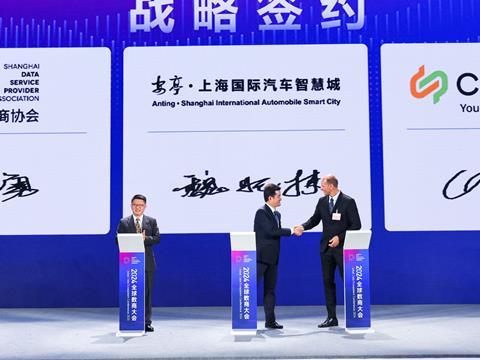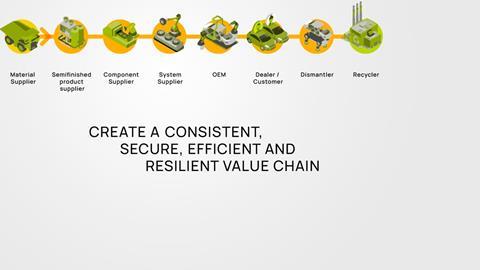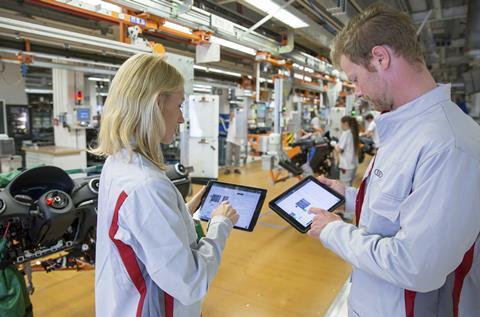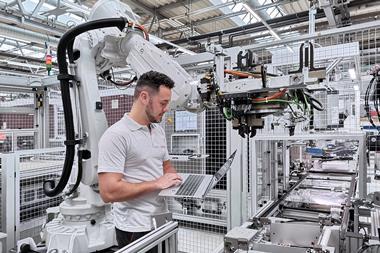Catena-X, the worldwide initiative to create an open data-sharing network, has moved into a new phase of international development. Audi’s head of digital strategy and portfolio management for production and logistics, Frank Göller, is head of internationalisation at the Catena-X association. He explains to Automotive Logistics how developing global standards for cross-border data exchange will make manufacturing logistics processes more efficient and resilient.

In the search for a more resilient supply chain, carmakers are concentrating on the development of digital tools for data management to build resilience into production planning and inbound logistics. In line with the Volkswagen Group, Audi is working on a cloud-based, SAP 4/Hana enterprise resource planning (ERP) system that will eventually cover operations such as transport order management, warehouse, yard and plant logistics.
It is also working on cloud-based product lifecycle management (PLM) tool to more closely control its vehicles from cradle to grave.
Audi has big plans to use digital technology to make production and logistics more efficient and effective, and Frank Göller, head of digital strategy and portfolio for production and logistics at the carmaker, is enhancing the exchange of data between Audi and the wider Volkswagen Group. What is important for each company is ensuring the overall master data collected for use is complete and free of error.
The strategy goes wider than the Volkswagen Group however, and the carmaker is part of a wider initiative across the automotive industry called Catena-X, designed to exchange data and increase end-to-end supply chain visibility. Göller is also vice-president of internationalisation at the Catena-X association.

The Catena-X association was founded in 2021 by the German Federal Ministry for Economic Affairs and Energy, and the German Association of the Automotive Industry (VDA), supported by 28 companies, each of which invested and created the founding standards and open-source software code needed to increase supply chain transparency. It currently has 192 participating companies and over 6,000 community members worldwide. The aim of this data space initiative is to improve the flow of parts and materials as well as helping to fulfil future regulatory requirements, such as product carbon footprint tracking, battery passports and circular economy regulations. Over the last three years the data ecosystem was built up to help users exchange data and information through a secure peer-to-peer system. The association has in that time established official open-source project called Tractus-X to support and grow the development environment for new software and services.
Read more: How Catena-X encourages more trust in data-sharing
The association also started Cofinity-X, the first company providing a marketplace for software packages and services, which is delivering the first unique identification numbers. It is the first example of what the Catena-X operating model looks like. The carmakers and tier suppliers involved are using the software provided to exchange several million data points.
Catena-X expands hubs globally to strengthen data standards
The Catena-X association is now also looking to grow beyond its founding OEM and tier one members to include global tier-n suppliers and logistics providers. It is reaching out on an international basis to enrich data sources and supply chain data to build global standards.
With recent developments in Europe, such as founding the first Catena-X Hub in France, and building additional hubs in Spain and Sweden, Catena-X is now reaching beyond Europe. Together with several active members in the Catena-X association, an Internationalisation Committee is in place to steer global developments and grow new Catena-X hubs in China, Japan and the US.
Frank Göller points to a couple of projects now underway. They include one to establish a battery passport, given the wider scope of companies exchanging data on battery production, logistics and usage beyond the OEM and tier one companies. Göller says the establishment of a battery passport requires a much longer data chain and that includes companies in China and the US, as well as Europe.
“In other regulatory topics, such as circularity, we have embedded disassembly and recycling companies,” says Göller. This inclusion of companies providing recycling services is in its early days but is growing fast. Göller acknowledges that Volkswagen Group, of which Audi is a part, has several thousand suppliers that are yet to be brought on board.
“That is a task that each big company in Catena-X has now focused on and the next phase is on-board the partner companies and really enrich the network,” he says.
Catena-X in the US and Asia
Catena-X recognises China, Japan and the US as big players in the automotive industry. The association has recently announced a collaboration with the US-based Automotive Industry Action Group (AIAG), which will act as Catena-X’s North American hub and open the data-driven automotive network to its 4,900 members. AIAG says the partners intend to formalise the agreement by the end of 2024 and prepare to launch the North American hub to automotive manufacturers and suppliers in early 2025.
AIAG CEO, Matthew Pohlman says partnering with Catena-X will strengthen the development of collaborative standards for the automotive industry and drive value for its members as part of a global network.

Göller says there is a great deal of interest from the AIAG to use Catena-X’s open-source software and share the standards for data exchange.
Catena-X has also started talks in Japan, where the Quranos project aims at promoting collaboration between Japanese and international automotive companies. “We are in very interesting talks that they are also very interested in the Catena-X activities. And we will bring our standards together so that that cross-border data exchange is also possible,” says Göller.
In China, Catena-X has recently held several discussions with government institutes and associations and has now also signed a MoU to build the first China hub for Catena-X in the Shanghai region.
“We also have this linked to the Chinese Association of Automobile Manufacturers (CAAM) and they are very interested in supporting joint cross-border data exchange standards,” says Göller. “There is still work to be done in China but we have had very positive feedback about the data space we are creating and how we can bring that together with those that are also growing in China.”
This additional international reach means there are around 6,700 companies, associations and institutes that Catena-X is in contact with. “That does not mean that they all use Catena-X at this very moment, but that means they have understood what is behind it and that we can grow our data space on this kind of platform of companies,” says Göller. “That is a very good starting point and if we continue that journey in 24 months, the footprint will be much bigger.”
Building global trust: Catena-X adopts standards for secure data exchange
This adoption on an international scale, especially involving China, indicates a significant step beyond the hesitancy that companies have expressed in sharing data. That is being pushed by equally significant regulatory requirements coming into effect over the next three to five years, according to Göller.

“Our analysis shows that over one billion data points have to be tracked, recorded and monitored for regulatory requirements up to the year 2030,” he says. “We have checked the different regulations in US, in China, in Japan – all around the world – and that means a really high amount of data tracking requirements by law.”
Catena-X offers a way of efficiently collecting secure and trusted data, as long as a way can be found to standardise such things as carbon measurement, which are calculated differently in different regions.
Volkswagen Group’s Catena-X use cases: Data accuracy, quality control, and bottleneck management
Volkswagen Group has three use cases selected for initial implementation but more will definitely follow, according to Göller.
The first relates to ensuring each business partner’s recorded master data is complete and free of error. “Business partner data management really assures that we only have one golden record of data and everyone knows exactly what are the right master data we need for the communication with our partner company,” says Göller.
The second use case relates to the real-time exchanges of quality data with partners enabling timely feedback and reaction to the quality measures taken.
“That is something not very spectacular in the beginning, but it is powerful when we have a network of several suppliers working on the topic because a tier one or tier two supplier can recognise a failure, and those companies are typically delivering to more than one OEM,” says Göller. “They can directly share information about a quality issue to the OEMs and other tier suppliers, warning them to be careful of an imminent failure and notifying that they are repairing or reacting to it.”

The third use case Audi is working on with Volkswagen is in short-term bottleneck management. There the carmakers are looking at selected material numbers with suppliers frankly sharing each other’s bottleneck issues, stock levels and delivery times to better steer production planning. Greater awareness of bottlenecks offsets disruption more quickly.
Within Audi more specifically Göller admits that the application of Catena-X is in its early stages but the carmaker recognises the potential strength it can bring to its operations and has been working hard on supply chain and logistics topics in recent years.
Creating long data chains will enable companies to reflect reality and simulate scenarios for supply bottlenecks, the carbon footprint of products or the circular economy, says Göller. The production and logistics environment can be dynamically displayed as digital twin helping companies become more effective and efficient.
Frank Göller will be talking more about the future of data standards at this year’s Automotive Logistics & Supply Chain Digital Strategies Europe conference, which takes place between December 3-4 in Munich, Germany.







































No comments yet